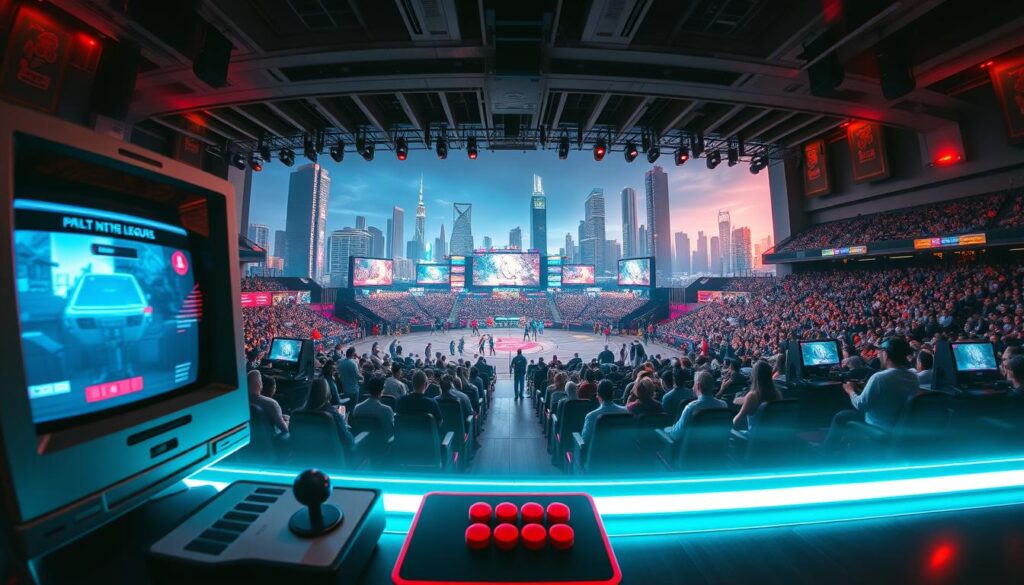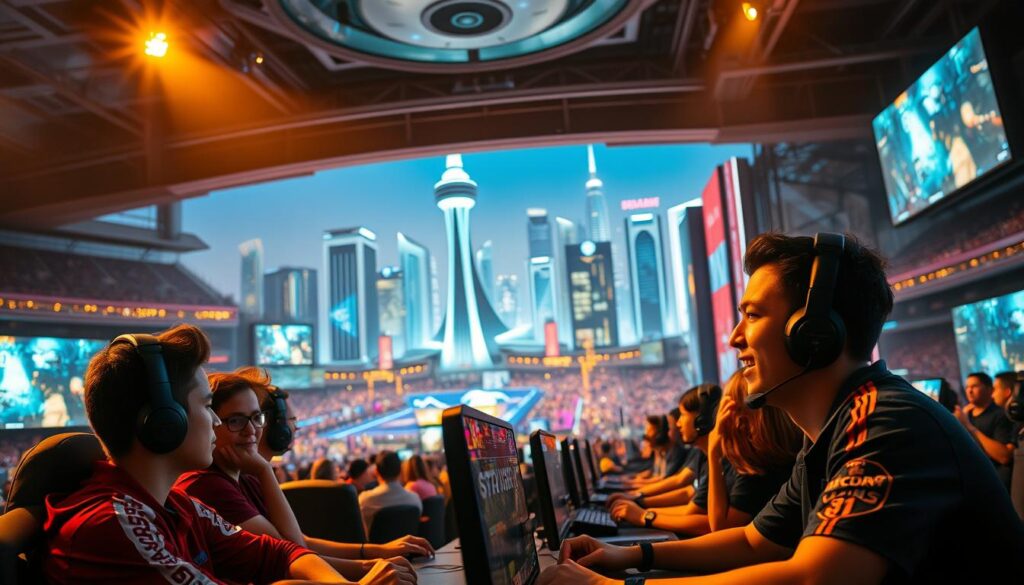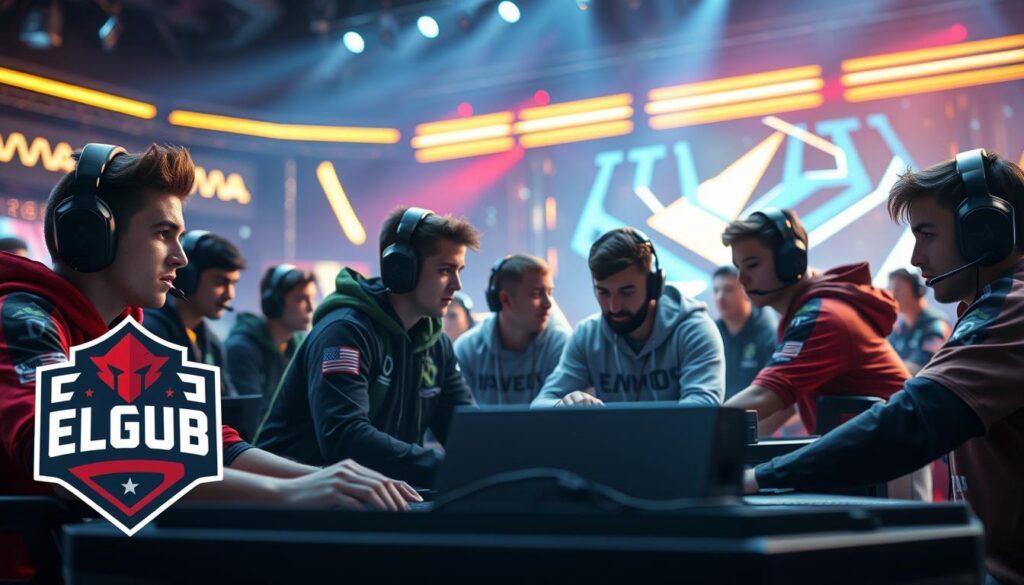Imagine sweaty palms holding joysticks in a dim lab at Stanford in 1972. There, the first “Intergalactic Spacewar Olympics” was held. Now, fast-forward to today, and gaming fills stadiums like Seoul’s LoL Park. Pro gamers there make more than many doctors do.
How did we leap from basement LAN parties to prime-time ESPN broadcasts and Olympic talks? It’s a story of how broadband internet turned gamers into global stars.
Remember when Pong was the latest thing? By the 90s, South Korea’s PC bangs became hubs for Starcraft players. They could earn money just by playing.
Then, Twitch came along, making streams a big deal. Suddenly, your neighbor’s kid could earn more than Wall Street pros with Fortnite.
Today, gaming’s history is like a Silicon Valley tale with amazing effects. When Valve’s The International DOTA 2 tournament offered $40 million prizes, even grandparents got it. Gaming went from basements to a major sport, changing entertainment and culture.
1970s–1990s: Early Competitions
Before Twitch and big prizes, gaming was all about burnt pizza and sweat. The esports timeline starts in 1980 with Atari’s Space Invaders Championship. It was like Woodstock, but with 8-bit processors and magazine prizes.
Over 10,000 players filled arcades, watching alien hordes. The top prize? A Rolling Stone feature and bragging rights until Pac-Man took over.
“We didn’t have sponsors or coaches – just sticky buttons and the guy behind the counter yelling ‘No leaning!'”
Arcades were where gaming’s first stars were born. They were dimly lit temples of competition. Legends like Billy Mitchell rose to fame through:
- Quarter-fueled rivalries lasting entire summers
- Handwritten leaderboards updated with religious fervor
- The sacred art of “pattern memorization” – gaming’s original meta
The big change came in 1997. id Software’s Red Annihilation Quake tournament offered a real car as first prize. Dennis “Thresh” Fong won a Ferrari 328 GTS, catching corporate attention. ESPN thought it was just “children’s button-mashing,” but it was too late. The genie was out, and it had a 56k modem.
| Arcade Era | Modern Esports |
|---|---|
| High scores etched in Sharpie | Blockchain-backed player stats |
| Prizes: Free games | Prizes: Private islands |
| Strategy: Gut instinct | Strategy: AI-powered analytics |
These early competitions set the stage for today’s esports. They showed that button-pushing could entertain crowds. Who needed football when you had a joystick?
The Birth of Online Play
Before Twitch and big tournaments, esports started with 56k modems. These old modems didn’t just interrupt calls; they helped start today’s gaming world. The real MVPs of esports were the lag and AOL’s “Welcome” screen.
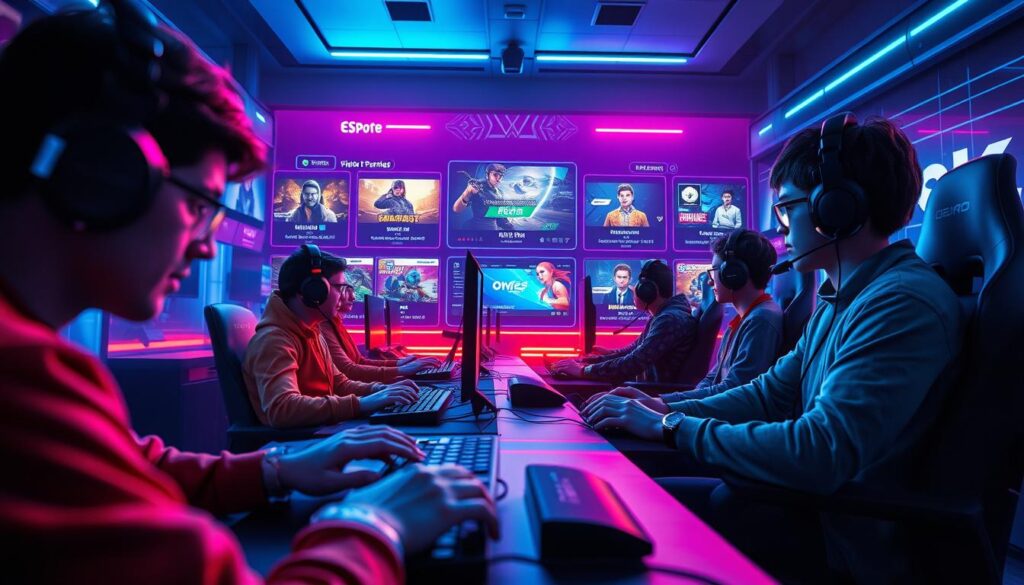
Battle.net was more than just a service for Blizzard. It was like the Roman Colosseum for gamers. In 1998, StarCraft made South Korean teens famous for their fast clicking. Internet cafes became places where future champions were made, while others dealt with constant disconnections.
Why is this old tech important today? Modern esports owes a lot to these early ideas:
| Tech Feature | 1990s Impact | Modern Equivalent |
|---|---|---|
| Dial-Up Modems | Taught players to adapt to lag | Fiber-optic reflexes |
| LAN Parties | First team-building exercises | Esports training facilities |
| Battle.net | Created global matchmaking | Cross-platform play |
The real genius of this time was turning problems into strengths. Players learned to play fast because of slow connections. Today’s pros have better equipment, but they stand on the shoulders of those who played well despite the odds.
When your WiFi drops during a game, remember the 90s pioneers. Their struggles helped create today’s esports stars, including Lee “Faker” Sang-hyeok. Gaming history is not just about winning. It’s about the players who kept going, even when the phone rang.
The Rise of Esports Leagues
Imagine competitive gaming moving from basement LAN parties to sold-out stadiums. The history of esports saw a big change when leagues became like pro sports. They had billionaire owners and merch hawkers. How did we go from basement gaming to Overwatch League teams like Paris and Shanghai?
The turning point was when people saw esports could make money. The Championship Gaming Series (CGS) in 2007 was a big try. It was like a $50 million disaster, trying to mix Counter-Strike with NFL style. It failed, showing you can’t force hype.
“CGS treated esports like a zoo animal – they polished the cage but forgot to feed the beast.”
But from the ashes, leagues like LCS and Overwatch League rose. They mixed community input with pro sports:
- City-based franchises (London Spitfire sounds way cooler than “Team Red”)
- Player unions and minimum salaries
- Merchandising that makes band tees look basic
Big changes came when sports owners like Stan Kroenke (LA Gladiators) and Jeff Wilpon (NY Excelsior) joined. Esports became a real career pathway with college scholarships and sponsorships.
Today, pro gamers are more than just players. They’re brand ambassadors, content creators, and sometimes equity partners. The esports development pipeline includes:
- Youth academies scouting 14-year-old prodigies
- Nutritionists optimizing reaction times
- Sports psychologists preventing tilt-induced meltdowns
Prize pools are now huge, like Wimbledon’s. The question is, will esports outlast traditional leagues? The NFL has never seen 1.3 million viewers for a regular season game.
Streaming and Globalization
Imagine MTV’s Moonman trophy turning into a Twitch emoticon. That’s what happened to Gen Z’s attention span. Justin.tv’s 2007 livestream, born from a vodka-fueled karaoke session, evolved into Twitch. It didn’t just change entertainment; it created a $15 billion digital arena where anyone could compete.
The key was accessibility. You no longer needed ESPN to watch professional gaming history. All you needed was a WiFi connection and a bit of sleep deprivation.
South Korea’s LOL Park, a 500-seat arena, is like Game 7 of the World Series. Yet, it’s 6,000 miles from Rio’s Free Fire battlegrounds. Both show esports is a universal language:
| Region | Game | Venue | Cultural Impact |
|---|---|---|---|
| Seoul | League of Legends | LOL Park | National sport status |
| Brazil | Free Fire | Mobile cafes | 30M+ monthly players |
| USA | Fortnite | Twitch streams | Gen Z’s “Monday Night Football” |
Twitch didn’t just kill MTV; it brought it back as a hyper-interactive platform. Why watch pre-recorded music videos when you can interact live during a historic esports timeline moment? The 15 million daily Gen Z viewers on Twitch aren’t just watching; they’re creating, turning phrases like “clutch play” into global language.
The real revolution is democratization. A kid in Manila can study Faker’s League strategies as easily as a Berliner analyzes Bayern Munich’s formations. Streaming has turned gaming history’s VIP section into a chaotic, sweaty, and inclusive mosh pit.
Milestone Matches & Iconic Games
What makes a moment unforgettable in esports history? It’s not just about skill. It’s the cultural earthquakes that change how we see competition. Let’s look at EVO Moment #37, the “Daigo Parry.”
This moment turned Street Fighter III into a digital ballet. Justin Wong’s Chun-Li had a super combo that should’ve ended the game. But Daigo Umehara’s Ken pulled off a frame-perfect parry—17 blocks in a row. His health was so low, it seemed like the hitbox was screaming.
This event had big effects. Developers started making games for spectacle, not just balance. Then, Dota 2’s The International came along, with a $40M prize pool.
Fans helped fund the event through cosmetic purchases. This created a self-sustaining economy. The 2021 champion team got $18M, which could’ve bought Twitter’s old HQ before Elon Musk.
CS:GO’s skin market is like a Wall Street parody. Virtual gun camos trade like stocks. That Dragon Lore AWP skin in your inventory? It’s why Valve reportedly owns a private island.
| Game | Year | Impact | Prize/Economy |
|---|---|---|---|
| Street Fighter III | 2004 | Redefined competitive mechanics | N/A (Cultural value) |
| Dota 2 | 2011-Present | Crowdfunded prize pools | $40M+ (2023) |
| CS:GO | 2012-Present | Virtual item economy | $100M+ annual sales |
These milestones changed esports development. Daigo’s parry showed esports could rival traditional sports. Valve’s monetization created a blueprint for leagues. And CS:GO’s skin market? It was like a real-life gold rush.
“That moment wasn’t about winning—it was about showing what’s possible when human precision meets digital design.”
Today, developers study these events like the Rosetta Stone. The lesson? Great games create champions, but legendary moments create empires.
Impact on Youth and Pop Culture
When did gaming move from basements to math classes? Fortnite’s “Floss” dance is now in NFL end zones. K-Pop’s K/DA beat Taylor Swift on iTunes, and esports scholarships are offered in high schools. The “gamer” label has changed from a negative to a positive.
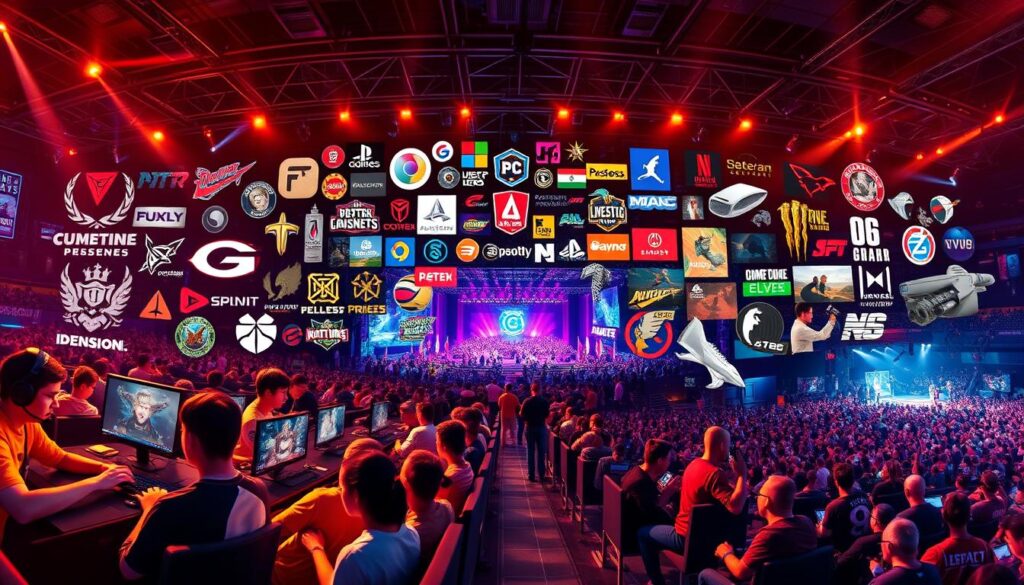
Imagine if every minute playing Smash Bros. Melee was money. We could fund NASA’s Mars colony. A 2021 study shows 72% of Gen Z sees gaming as a key part of their identity. That’s more than political or religious beliefs.
Gaming has changed more than just screens. It’s now in language labs and on Twitch. Your niece might say “D.Va main” on TikTok. This shows how gaming has become a cultural mirror.
Three ways gaming changed the playground:
- Career paths: Over 300 U.S. high schools have varsity esports teams
- Fashion: Streetwear with League of Legends is more popular than band tees at Coachella
- Economics: Roblox developers under 18 made $328M last year
Next time someone doubts gaming, remind them: the esports timeline created a world where Ninja is more famous than ninjas. Game over, skeptics.
The Future of Esports History
Let’s get real about esports. It’s not about VR avatars without legs. It’s about who’s ready to invest in the next big thing. From Riyadh’s oil wealth to AI coaches, let’s explore what’s really important in gaming’s future.
Here are three trends that will make tomorrow’s champions stand out:
- AI Game Whisperers: Machine learning tools that analyze player skills faster than a Twitch troll. It’s like Moneyball for gaming stats
- VR’s Second Coming: Meta is pushing VR tournaments, but real innovation is happening in mixed-reality labs worldwide
- The Saudi Play: A $38 billion gaming fund is more than just investment. It’s a move to gain global esports influence
“We’re not buying teams, we’re building the infrastructure for global esports citizenship.”
Not every new idea is worth celebrating. NFT trophies are just digital waste. Blockchain esports platforms are cool if you enjoy paying extra to watch games.
The real game-changers are in Seoul’s gaming history labs. AI coaches there:
- Analyze opponent strategies with old match data
- Personalize training plans based on your body’s signals
- Simulate tournament pressure with haptic suits
Saudi Arabia’s esports push is raising some questions. A developer in Riyadh said, “We’re not just building arenas. We’re creating the esports economy from the ground up.”
Competitive gaming is facing an identity crisis. With AI coaches and VR fans, what are we preserving in gaming history? Get ready for the next level of gaming.
Conclusion
The history of esports is like a cheat code for being cool. It started with simple games in basements and now fills huge stadiums. People watch and analyze games like they’re watching Shakespeare.
Streaming sites like Twitch made regular people into stars. League of Legends tournaments even got more viewers than the Super Bowl. The future looks bright, with the metaverse bringing new ways to play.
This world didn’t just create jobs. It changed how we show our team spirit. Now, even your grandma knows who Ninja is. It’s not just about being fast; it’s about building a community that loves memes and spreadsheets.
As we get ready for the next game, remember: every joke and argument adds to esports history. It’s not just about winning; it’s about the stories we share online. Let’s keep playing.

